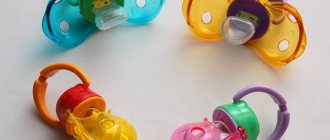The best time to start potty training
We are not talking about age, but rather about the period of development.
Potty training is essentially the restructuring of an unconditioned reflex (an uncontrolled process) into a conditioned one. And the child must be ready for such a change. Thus, according to experts, there are three main factors, based on the compliance of which you can begin to potty your offspring:
- Timely development and absence of pathologies of organs directly involved in the process of urination and defecation (bladder, urethra, rectum, abdominal muscles).
- Psychological and physical activity. The offspring must be sufficiently developed physically, have primary speech skills and be able to walk. Obviously, if a child cannot tell adults that he wants to pee and get to his destination on his own, teaching him to go to the potty without supervision will not be easy.
- The willingness of dad and mom to go through this difficult path together with their little one. Toilet training is a long-term undertaking that requires constant supervision from adults, an attentive and caring attitude towards your child. As practice shows, it is advisable to start introducing a child to the potty at the age of one and a half to two years. It is during this period that the baby has all the necessary skills, understands his physiological needs and is psychologically ready to perform the actions necessary for this process.
A common misconception: many parents manage to teach their child to go potty before the age of one year by sitting down and developing a reflex to sound communication, namely with phrases like “pee-pee” and “ka-ka.” The method is effective, but has a short-term nature, and after the child’s worldview is reshaped at the age of two, the acquired skill will lose its durability and will require retraining by other methods.
In any case, there are practically no children who have not fully mastered the skill of going to the toilet independently by the age of four - this is the age that is considered the maximum among practicing pediatricians and is a deviation of a physical and psychological nature rather than a failure of mom and dad.
What is important to check before starting training?
Before starting to teach your child to sit up on the potty while sleeping at night, parents should ask themselves the following questions:
- Is the child over 2 years old?
- Is the child healthy?
- Can the child do something on his own without the help of his mother? For example, eat with a spoon, communicate your needs and needs?
- Will the child be able to fall asleep on his own at night after waking up to go to the toilet?
If you answered no to at least one of these questions, this means that at the moment the baby is not quite ready to handle the potty on his own at night.
Some diseases, such as cystitis or diabetes, directly affect the process of urination, often making it difficult.
What can parents do to make potty training easier?
- Remember about age restrictions. If the baby is less than 2 years old, but at the same time he is already quite independent and already knows a lot and can do something without the help of his parents, then he can start potty training. But it is also important to remember that a high degree of self-organization should not yet be expected from a child much younger than 2 years old due to physical development and insufficient maturity of the nervous system.
- If the baby is not healthy, he needs the help of his parents . It is important for parents to understand that potty training is not only an educational psychological process, but also a process that largely depends on physiology. In the case of some diseases, you should be patient and not insist on a quick result.
- Help your child develop his independence. After the baby reaches the age of 1 year, parents’ encouragement of the child’s independent actions is one of the main forms of stimulation of his development and strengthening of attachment. The development of a baby largely depends on the environment in which he grows up: how safe the environment is, how many opportunities there are for trial and error, how willing parents are to support the baby in his endeavors (first steps, falls, first words and desires).
The child should have his own personal area of responsibility, that small area where he does something himself (assembles the pyramid himself, walks himself, eats with a spoon himself). Despite the fact that his mother is nearby, encouraging and supporting him, but without interfering unnecessarily.
- The last, but very important point is the baby’s ability to fall asleep on his own. The acquired skill of falling asleep independently will help the baby in learning to wake up on the potty. Knowing how to fall asleep on his own, it will be easier for him to wake up on his own, feeling his needs.
When to start
By the age of two or three, many children can live comfortably without diapers. They ask or sit on the potty on their own. That is, during waking hours the child has already learned to control his body.
During sleep, some babies cannot recognize the urge to urinate. This leads to unforeseen situations. How to teach a child to get up on the potty at night? First, the parent needs to understand: it will take some time for the baby’s brain to give a signal to wake up. A child can be taught this, it just takes practice. And after some time, the baby will be able to remain dry throughout the night, as the volume of the bladder will increase and the nervous system will be strengthened.
What is important to check before starting training?
Before starting to teach your child to sit up on the potty while sleeping at night, parents should ask themselves the following questions:
– Is the child over 2 years old?
– Is the child healthy?
– Can the child do something on his own without the help of his mother? For example, eat with a spoon, communicate your needs and needs?
– Will the child then be able to fall asleep on his own at night, waking up to go to the toilet?
If you answered no to at least one of these questions, this means that at the moment the baby is not quite ready to handle the potty on his own at night.
Some diseases, such as cystitis or diabetes, directly affect the process of urination, often making it difficult.
Early training problems
When starting to potty train a baby too early, for example at 7-10 months, mothers are faced with negative consequences that will appear a little later:
- The little one used to sit on the night vase, but by the age of one or a year and a half he stopped sitting on it, crying and getting irritated.
This is due to the fact that the child has developed natural control over the desire to go to the toilet. The treasured “wee-wee” simply doesn’t work on him. He wants to wait for the need, the urge to urinate from the body, and does not stop obeying his mother.
- Unstable neatness skills.
The baby goes to the potty occasionally, expects his parents to sit him down and make appropriate sounds for the urge to go to the toilet. For example, the sound of gurgling water, grunting for bowel movements from the mother.
- Protests by the little ones lead to aggression on the part of the parents.
Mothers, upset by the misbehavior of small children who recently sat on the potty and did not cry, use force. They force me to sit on a vase for a long time and scold me. But the baby does not understand the reason for the dissatisfaction and denies it. A fear of the potty develops.
Patience helps you avoid these problems. Don't rush things. Start teaching neatness on time - at 18-24 months, when you see the first desire to acquire a skill.
Potty games
It's no secret that all children love games. And if adults also play with them, then they are simply delighted. This means that it is precisely this feature of the child that needs to be skillfully used in order to potty train him. What games can you offer your child when he is sitting on the potty?
- Finger games and nursery rhymes. For example, Thief Magpie, Ladushki, Dereza Goat. You can learn other finger games on video.
- Build a tower from cubes or create a pyramid.
- The simplest crafts from the designer
- Animal voices. Show your child a picture or figurine of an animal. And then make characteristic sounds. Ask your child to repeat with you.
- Drum. xylophone, harmonica.
- Tongue or lip games can also keep your child engaged. Teach him to stick out his tongue in different ways, blow, whistle, click his tongue. As a result, you will not only have fun, but also usefully spend time on the potty. And all these skills will contribute to the correct formation of speech in your baby.
- Make funny faces with your child, this will also be useful for his development
- Invite your child to get angry, especially if he is in a bad mood and does not want to sit on the potty. To do this, tell him that he needs to sit on the potty and clench his hands into fists very, very tightly.
- Tell your child an interesting story or read him a book
- Turn on a cartoon for your baby
In fact, this is just a small example of how you can teach your child to go potty in a fun way.
Moreover, in order to potty train a child, it would be good to allocate special toys for this. But do not give them to your baby when he is not on the potty. This way you will make your baby more fond of the potty.
So, dear moms and dads, turn on your imagination and act. But do not force your child to sit on the potty! In addition, you should not keep your child on the potty for hours. There should be common sense in everything.
Useful cartoon on how to potty train a child:
Signs of readiness to learn
Take a close look at your child. Determine the degree of readiness for pottery by the following criteria:
- The child is over 18 months old.
- He is happy and dry for one and a half to two hours.
- Understands what pooping and pooping means.
- Cries if he wets himself and puts on his panties.
- He knows how to let his mother know that he needs to go to the toilet (he gets nervous, pinches his legs, freezes, pulls her hand, knows how to wait, etc.).
- He wants to take off his clothes and put them on himself, and he succeeds.
- He knows where his arms, legs, butt are, knows how to show them and name them.
- He sits quietly playing a game and watching cartoons for a few minutes.
- Fulfills some requests: go, bring, give.
- Points to wet panties, expressing dissatisfaction with a grimace.
We recommend reading: Colic in newborns and infants: symptoms and treatment
If your baby belongs to the group of children who can do it all or really want to learn it, then you can start learning toilet literacy. If not, delay the parenting process for a couple of months.
Suitable age for potty training, when to potty train a child
Different sources indicate different recommended ages for potty training a child. I believe that basically you need to listen to the child. You cannot measure all children with the same ruler. Each baby develops at its own pace. Some are ready to go potty in a year, others in two. It is necessary to understand how ready the child is to use the potty. That is, can he already control his urination, does he understand that now he is peeing, and now he is pooping.
Early disembarkation of the baby: what and why
In infancy, a child is simply not able to control and understand his body. Early planting ensures a close bond between mother and child. And nothing more.
The benefits of leaving your baby early
Mother-child connection. The mother learns to be sensitive to the child's needs, his need to pee or poop. Thanks to planting, the mother clearly understands the child’s routine. Due to the fact that the mother watches the baby every second, she is completely attuned to his wave. This helps her recognize not only the need for the toilet, but for food, for attention, or to eliminate any anxiety.
You need to understand that in the future in the process of potty training your child, early planting will in no way help you or your child in this. Unless the child begins to understand earlier than others that he wants to go to the toilet.
Disadvantages of leaving your baby early
Early planting requires 100% attention and presence of the mother. That is, successfully not getting your pants wet is the merit of the mother alone, and not the child. Moreover, this leads to constant inconvenience and awkwardness. This means that you will not be able to walk in cold weather, because you will not plant a naked child in the bushes. And in public places, in principle, there will be a moment of awkwardness. In this way, the mother completely forgets about herself, about her life besides the child, and does not go anywhere.
An even worse option is when you fooled around with early drop-off, and later started putting diapers on your child to go to the clinic, children's party, and so on. And what ultimately nullifies all your torment.
The following points will tell you when you need to potty train your child:
- The baby asks to change his wet diaper.
- The child understands that he is now peeing or pooping.
- The baby may not write for at least an hour.
- You notice that the baby seems to be getting ready to “go to the toilet”; perhaps he even has a favorite place in the apartment for this, for example, behind the sofa somewhere in the corner.
- The most obvious thing: the baby himself tells you in plain text that he needs to go to the toilet.
It is advisable to start fighting the pot in the summer, during the warm season. Because in winter, wet pants can affect your child's health.
Which pot should you choose?
The ideal potty is not pink and blue, purchased based on gender, but one that meets the anatomical features of the child’s body structure. You need to select it according to the following characteristics:
- Form . Boys - oval, girls - round.
- Presence of a protrusion . Required for boys.
- Thermal conductivity of the material . A cold pot causes unpleasant emotions, a feeling of disgust towards the procedure. Opt for plastic models.
- Comfortable seating . The first potty should be suitable for height and butt size. Buy the version with a backrest. The baby will comfortably lean on it at night, early in the morning, peeing half asleep.
- Sustainability . The safety of the baby is ensured. The edges should be pressed tightly to the floor. Distortions and bends in the frame are typical for defective products.
- Pot without additional functions . Leave the songs and lighting for musical toys.
What are the reasons for failure?
In general, we can say that most failures simply relate to a difficult period of time for children.
Firstly, the period of teething or illness. The baby feels such discomfort that all his thoughts are directed only at this. He just has a hard time concentrating on anything else.
Secondly, the time of the crisis is one year. During this period, children simply protest to do anything. Thirdly, when the baby is passionate about the game. He simply does not notice anything other than the object of his interest and forgets to go to the toilet in the right place.
I repeat once again that in case of “accidents”, do not swear at the child. He's just learning. This way you can simply ruin the child’s psyche and cause an aversion to the potty.
Useful tips
For effective toilet training, parents can use some tips and tricks:
- Follow the regime and system of action. Avoid diapers. Don't stop putting your child on the potty every hour or two, after sleep and meals.
- Bring the night vase to your child, rather than leading your child to it.
- Wear simple clothing, without fasteners or zippers. It is important that it is easy to take off and put on.
- Don't keep your baby on the potty for too long. Five to seven minutes is enough. The night vase should be within sight and reach of the child. In this case, he will be able to sit down and defecate on his own.
- Let your child choose the first potty.
- Do not interfere with your baby if he decides to explore his genitals. Let him know how his body works.
- Make a poster or display to mark the baby's achievements. Glue stars for dry days, give small gifts at the end of the week for being neat.
- Give praise after every successful process.
- Don't scold kids for mistakes. This will provoke a negative reaction.
- If the baby arches his back or yells, do not insist on the process. Let some time pass.
- Offer to defecate outside in the bushes, take spare clothes for a walk.
- Tell your baby that walking in dry pants is good, but wearing wet pants is bad and unpleasant.
- Take a funny photo of your child on the potty. Hang it in your room, let him admire himself, realizing his own adulthood.
- If there are other children in the family, place them in the toilet with the youngest. Let them share useful experience and set an example.
- Do not try to form a habit during a period of illness or bad mood.
How to properly potty train a girl
Girls are more concentrated, less distracted by outside objects, so their learning progresses faster. Children who have older brothers and sisters are more successful in mastering hygiene items. Parents should clearly explain to the baby the structure of her butt and genitals, tell why it is important for her to go to the toilet while sitting, unlike her dad or brother. You can select several images from books or videos that will help your daughter understand the meaning of the new information. For example, with a child, they often sit their favorite toy on the potty. Girls should have practical underwear that the child can take off and put back on independently. It is important to teach a girl how to use toilet paper correctly. It should be moved from front to back, especially after defecation, to avoid infection in the urinary tract. The potty should be placed in a place accessible to the child. The girl should be praised for a successful visit to her “friend.” But freezing, jumping up and down in place, hugging the legs or swaying indicates the need for the baby to sit on the potty.
How to teach your baby to wake up and go to the toilet on his own at night?
When the main stage of training has been completed, and the need to put the baby on the potty has disappeared - he can already ask on his own, or even does all the “necessary things” without the help of his parents, it seems that the moment has come when you can take a break from constant control and relax. But the following problem arises: using the acquired skill at night, while sleeping.
The child is fast asleep, and, accordingly, cannot yet control his physiological needs. He simply does not understand what he wants, for example, to write and continues to sleep, emptying his bladder right in his sleep.
You can train your child to sit on the potty with a little effort, patience and understanding. The main thing in this matter is to clearly apply the basic rules of learning to get up to go when needed.
Wait until your child is ready to potty train
As with many other aspects of child development, it will take you much less time to potty train your child at night if you wait for the right moment.
Here are some signs that your baby is ready for the transition to an adult toilet:
- The child asks you to remove his night diaper.
- When the baby wakes up, he asks to go to the toilet.
- The baby's diaper is dry after sleeping several nights in a row.
- Night panties are only slightly damp in the morning
Prepare before potty training your child to wake up at night
There are a few things you should do before teaching your child to potty at night. Getting up at night will be much easier if you think about what obstacles may arise. Our tips on how to potty train at night will help you prepare for this process in advance and make nighttime potty trips more comfortable:
- Place a water-repellent mattress on your child's bed.
- Place the potty next to your baby's bed if the toilet is far from his room.
- Leave a light on the stairwell if you have several floors, or just a portable lamp in case you move around the apartment to the toilet.
- Before going to bed, be sure to teach your child to go to the toilet.
- Ask your child to use the toilet as soon as he gets up in the morning.
- Prepare a spare set of bedding and pajamas in advance to be prepared for emergencies.
Talk everything over with your child
Spend some time during the day in the weeks leading up to bedtime weaning to explain to your baby why he needs to get out of his warm crib and go to the toilet, and show him how it works in practice. Offer rewards for successful nighttime toilet trips, and if your child has older siblings, include them in the process. This way things will definitely go faster.
Your child may have questions such as will he be able to call you for help if something happens if he doesn't see something at night? Explain that it is just as important at night as during the day to follow the same personal hygiene rules: wiping, flushing, and washing your hands after using the toilet.
Make nighttime trips to the toilet as comfortable as possible for your child by using Zewa Deluxe Soft Toilet Paper and Zewa Wet Toilet Paper.
Less fluid at night means fewer problems
It is worth planting on a potty during sleep only if there is such a need. The purpose of this action is to wean the child off diapers while keeping the bed dry and clean. Some babies stop peeing in bed at night on their own after two years; some need parental help.
We recommend reading: Why does a baby spit up after breastfeeding?
And the basis of such assistance will be the control of fluid in the child’s body before bedtime: first of all, it is necessary to reduce its consumption in the evening and reduce it as much as possible two hours before bedtime; and of course, you need to put the children on the potty before going to bed at night, so you don’t have to wake him up later.
At night, all processes in the child’s body slow down, and the accumulation of fluid in the baby’s bladder will also take a longer time, thereby reducing the possibility of uncontrolled urination during the period of sound sleep.
Should I wake up or not: that is the question?
Many parents resort to such a common method as forcibly waking up their children to urinate. As experts say, it is absolutely forbidden to wake up children whenever you want. Sleep is a rest not only for the body, but also for the spirit, and by exposing children to such an unnatural awakening, fathers and mothers, without realizing it, harm the nervous system of their child, which can lead to very negative consequences. But it is still necessary to be sensitive to the baby’s signals in a dream.
If a child has consistently developed the skill of controlling natural needs during the day, then at night, his body will follow the learned reflex and give signs of the need to go to the toilet. But the baby himself will not immediately begin to understand these signals, but dad and mom are quite capable of this.
So, at the time when the baby wants to write, his sleep will most likely become less sound: he will begin to fidget in bed, make sounds, and moan. It’s at such moments that you should very carefully wake up the baby, stroking him on the back, whispering kind words and mentioning that he wants to pee, and taking him to the potty. Only the timeliness of this procedure, a gentle and sensitive attitude, and a serious approach from parents guarantee quick and reliable results in toilet training at night.
Less fluid at night means fewer problems
It is worth planting on a potty during sleep only if there is such a need. The purpose of this action is to wean the child off diapers while keeping the bed dry and clean. Some babies stop peeing in bed at night on their own after two years; some need parental help.
And the basis of such assistance will be the control of fluid in the child’s body before bedtime: first of all, it is necessary to reduce its consumption in the evening and reduce it as much as possible two hours before bedtime; and of course, you need to put the children on the potty before going to bed at night, so you don’t have to wake him up later.
At night, all processes in the child’s body slow down, and the accumulation of fluid in the baby’s bladder will also take a longer time, thereby reducing the possibility of uncontrolled urination during the period of sound sleep.
Additional measures
If the usual training method does not give stable results, visit a pediatrician. A child may regularly pee in bed at night due to a bladder infection. If you are prone to infections, it is important to boost your baby’s immunity.
A visit to the doctor will also be required if, after a long period of dry nights, the child suddenly begins to regularly wet the bed again. The cause may be illness or severe stress.
Teaching a two- to three-year-old child to stay dry at night can take several months, it all depends on the characteristics of the child’s body and development. Over time, everything will return to normal if you treat your baby with love and care.
We sleep without diapers
It is much easier to give up diapers during the day than at night. During the day, you can catch the moment when a child wants to go to the toilet. It’s more difficult at night, but if he starts going to the potty all the time, you can put him to bed without them.
Children are different, not everyone is able to control urination, so in such cases, diapers and oilcloth will come to the aid of mothers. Over time, the baby will learn to wake up at night on his own when he wants to go to the toilet.
To teach your child to sleep without a diaper, you need to:
- approach this gradually, do not insist;
- do not drink before bedtime;
- before going to bed, let him sit on the potty;
- leave low lighting: if he wakes up, he can go to the potty on his own;
- sit down again in the morning;
- If the little one gets up dry, be sure to praise him and focus on the dry bed.
Please note that children who sleep in diapers continue to pee in bed until they are 3-4 years old, and those who gave up on them early by the age of 2 stop peeing on themselves at night and get up on their own.
What if a child is afraid of the potty?
Fear of the night vase in children is due to the following reasons:
- Unsuccessful introduction to the potty . It was cold, wet, and simply a scary object for the baby.
- Trauma . The kid fell off him and hit himself.
- Lack of support and praise from parents . At the first stages of toilet training, the final result is necessary only for adults; the baby tries to understand what you want from him, tries to please his mother. Don't be greedy with kisses and hugs.
- Untimely training . Parents tried to develop the reflex by violent means at a very early age, acting obsessively.
- Lack of normal conditions for peeing and pooping in the kindergarten.
- Sitting on the night vase for too long . Strict parents achieve results by holding the baby on the potty for several hours, expressing dissatisfaction with the child’s sluggishness.
- Children's fantasies . The kid draws scary pictures in his head about monsters in the toilet. He screams and gets hysterical at the first attempts to sit him down. Ask your child about it and check out who lives there together.
- Pot too big . The baby sits awkwardly, afraid of falling through.
- Constipation . The baby associates painful sensations during bowel movements with the potty. Explain to your child that a plastic toilet has nothing to do with it, change the children's menu so that hard feces do not bother him, and the baby poops painlessly.
You can correct the situation as follows:
- Let the situation go for a couple of weeks, even months. Move the pot away.
- Don't scold your baby. The less you freak out, the calmer the child will become.
- Create a comfortable psychological environment at the time of defecation and peeing.
- Buy a new pot. Let the baby choose for himself.
- Place the potty in the room first and let the child get used to it externally.
- Explore a new object for your child together, place a toy on it, and show how to use it.
- Together, come up with a fairy tale about magic pots, brave boys who overcame fear, became strong and brave. Talk about this topic more often.
Important ! Lack of pressure from parents, patience, and help in overcoming a phobia help the baby not be afraid of the terrible potty and get used to the new procedure faster.
How to properly potty train a boy
Training boys to use the potty requires time and patience on the part of parents, as well as mutual cooperation and motivation from sons. It is believed that girls cope with the task faster. The learning process begins only when the boy is interested and physically ready for it. Early learning may be delayed and cause negative emotions towards the subject. It is important to choose the right potty so that the child, while sitting on it, touches the floor with his feet at a slight angle. For boys, buy an oval-shaped object with a small protrusion in front. First, the child must get used to the new object. The boy should be explained that the potty is his property. You can even sign it or decorate it with a sticker. At first, the boy is allowed to sit on the potty in clothes. After a week of getting used to it, the baby is asked to take off his clothes. At the same time, avoid any forceful movements. If your baby has a favorite toy, you can use it to demonstrate the functions of the potty. The boy is first taught to relieve himself while sitting, and then they try to transfer him to a standing position. As an example, you can show the actions of an older brother or dad.
How to wean yourself off diapers?
Giving up diapers during the daytime is easier than at night. Don’t wear reusable panties at home, and in kindergarten too. Use the children's toilet before going out. On the street, periodically invite your baby to run into the bushes or take the potty with you.
Praise your baby if he asks to go home because he wants to pee. Soon you will be able to endure it longer; you won’t need spare clothes. Limiting what you drink two to three hours before bed will help you stay dry at night.
You should not categorically refuse night diapers until the age of 2 years. Afterwards the child will wake up and ask to go to the toilet. And wet sheets will help with this. During this period, mothers will have to sensitively and often approach the crib to check the dryness of the panties, change the sheet, and lift the baby to pee.
Become a psychologist
When teaching a child any skill, the approach and psychological component are very important. Here are some tips to help set your baby up for learning and help him master the much-needed skill of going to the toilet at night.
Avoiding diapers at night
During the dark period of the day, you can use oilcloth and put your baby to sleep without diapers. At the same time, it is worth informing the child that now he is completely “adult” and when he wants to go for a small need, he must inform his mother about this or go on his own. This will help him learn two lessons: first, that sleeping in a wet puddle is not comfortable, and thirdly, to start developing a sense of responsibility.
If you are afraid that at night a child without a diaper and pees at night may end up without a blanket and on a wet sheet, and therefore freeze, then you should use disposable diapers - they absorb liquid well, locking it inside and in a limited space. Also use insulated pajamas or special sleeping bags for children to prevent them from unwrapping and freezing.
Choosing a pot
Modern manufacturers offer a huge selection of children's potties of different colors and shapes, often supplying them with entire play complexes, and dad and mom go to all possible tricks so that their child willingly sits on it.
But you should understand that a potty is not a toy, and it is wrong to impose such associations on a descendant. The main thing in such a children's toilet is stability, the correct shape (it is different for girls and boys), compliance with the weight and height of the baby (this can be read in the product passport), safe materials that are used for its manufacture. The simpler the pot, the better.
Ensuring safety, peace and comfort for the baby. At night, a night light should be lit in the room, and the potty itself should be placed not far from the crib and an unobstructed path to it should be provided. It is better to do all actions aimed at training quietly and calmly, so as not to cause fear.
At the right time, in the right place
If a child, for example, is sick, this is not quite the right time to learn new things. A change of environment: moving or vacation can also affect the pace of learning. All this is important to take into account.
When should you see a doctor?
You should seek medical help if:
- The three-year-old child has not developed the skill of neatness .
In the fourth year of life, the baby does not feel the need to stay dry. Doesn't pay attention to wet pants during the daytime.
- Continues to write at night at age five .
In this case, we talk about developmental pathologies and congenital anomalies. Involuntary bowel movements and repeated uncontrolled urination are signs of functional and mental disorders.
Contact a pediatrician, urologist, and with girls, a pediatric gynecologist. The specialist will prescribe an examination: ultrasound of the kidneys, bladder, urine test. If the functional system is developed without disturbances, no pathologies have been identified, contact a neurologist.
Night awakenings
Parents managed to develop a habit; now they don’t need to wake up their child at night to go potty. He can already feel his bladder. Now he needs to explain that when he wants to go to the toilet, he can safely call mom or dad. Having gotten used to waking up his parents if necessary, the baby will learn to get up on the potty at night. However, sometimes “accidents” can happen. Therefore, it is better to be patient and have clean bed linen.
It is worth remembering: so that the child does not feel fear after waking up, a night light or table lamp should be turned on in the children's room. And also place the pot strictly in a certain place.
Causes of nocturnal enuresis
Why does a child pee in bed at night:
- The problem of childhood enuresis may be genetically determined.
If one of the parents peed in the bed as a child, with a 40–50% probability this problem will affect his child. If both parents have experienced bedwetting, the risks increase to 80%.
- Enuresis may be associated with pathology of the nervous system (consequences of injury, increased anxiety, stress, previous perinatal encephalopathy, various neuroinfections, etc.).
- Pathologies of the brain and spinal cord.
- Urinary tract infections, urological and endocrine diseases.
- Weak pelvic floor and pelvic muscles, decreased bladder tone.
- Neuroses, obsessive states.
We recommend reading: Stool in a breastfed baby: how many times should there be, pathologies
In most cases, nocturnal enuresis is a psychological problem. Often a child pees in bed at night from a lack of attention, or from its excess.
A wet bed can be a sign of protest against excessive parental care, and also indicate that the child is afraid of something.
Boys, as well as fearful, shy children, are most often susceptible to nocturnal enuresis.
Important! Up to 20% of children with bedwetting recover spontaneously.
Until what age can you wait?
The main reason why children wet their beds is the immaturity of the nervous system. It is she who is responsible for regulating the process of urination. Over time, the nervous system strengthens, and this problem disappears on its own.
However, not every parent is ready to wait for a natural solution to the problem of how to potty train a child at night. Therefore, young mothers begin to re-read all existing information and find that this situation should be resolved by the age of 4. And if the child is already 5, then for them this is a real disaster.
The famous pediatrician Komarovsky claims that a four-year-old child should fully control daytime processes, and a six-year-old child should control nighttime processes. Until this age, there is no need to panic. But every year the situation should improve: at 4 years old there are 20 dry nights in a row and one with an “accident”, and at 5 years old there are already 22 and only one “embarrassment”.
What does Doctor Komarovsky say?
Evgeny Komarovsky, a popular pediatrician who can be found on television shows, gives interesting and practical advice on the health and behavior of children.
He enjoys great authority among many parents and grandparents, as he explains even the most complex issues simply and clearly.
Komarovsky offers parents a small test, the result of which will show whether the child is ready for the potty or not. If most of the answers to the following statements are positive, then it’s time to potty train your child:
- the baby can remain dry for an hour and a half;
- the baby understands what “pipi” and “kaka” mean;
- the process of defecation is stable, the child goes to the toilet “largely” regularly, at approximately the same time;
- the baby knows the main parts of the body and can show them on himself or on another person;
- the baby begins to be capricious when his diaper or panties become wet, he feels discomfort;
- can independently remove some of his clothing, for example, lower his pants or panties.
However, the most important sign, according to Dr. Komarovsky, is certain gestures and sounds that the child makes when he wants to write.
He may squeeze your legs, try to take off your panties, press your hand to your crotch, or hold your tummy.
If you notice such an action in your baby, then it’s time to teach him to sit on the potty, including at night.
As you can see, there is no need to rush and panic if your neighbor’s daughter started asking to go to the toilet at night when she was two years old, and your 2.5-year-old son just can’t make friends with his earthenware friend during the day.
Between 1 and 2 years of age, children are toilet trained. How to teach a child to ask to go to the potty without tears and hysterics - we use the gingerbread method.
Each child is individual, therefore, everyone has their own time X. Engage with him, play educational games, tell stories and poems, just communicate. After all, the development of your baby primarily depends on you.
However, don't run faster than the locomotive! You still can’t fool nature. It is impossible to teach a child to ask to go potty at night if he is not physically and mentally ready for this. Wait a month or two and try again. You will be surprised how quickly a baby is able to learn about the world and himself.
How to train your child to go potty at night
Pediatricians say: if the baby is not yet 2-2.5 years old, then there is no need to worry.
Do not forget about individual developmental characteristics. Some children start asking to use the potty from one year old, while others continue to pee in kindergarten.
Here are some simple but effective ways to teach your child to ask to go potty at night, which will be useful for young parents.
How to treat?
As previously noted on sympaty.net, the main reason is the immaturity of the baby’s psyche. He himself needs to really want to get up at night to go to the toilet. Don't wake up your son or daughter at night, as many parents do. Yes, the child needs a push.
But if you regularly wake up your baby to go to the toilet to do his business, his psyche will still be waiting for your push - they should wake me up. This is the most important mistake that many adults make when trying to treat children’s nocturnal enuresis at home.
Drinking regime
All doctors advise reconsidering your baby’s drinking regime. The first half of the day should account for 40% of the liquid drunk, another 40% should be drunk before 17.00, and the remaining 20% should be drunk after 17.00. After lunch, especially in the evening, you should limit your drinking of caffeinated drinks.
Bladder training
One of the tricks that helps solve the problem a little is bladder training. If your child asks to go to the toilet, ask him to be patient for a minute and hold his urine. This technique is of an auxiliary nature, but can become one of the methods for treating nocturnal enuresis in children.
Motivational therapy
Your task is to praise and encourage your baby. You can start using this method from 5 to 6 years of age. Moreover, this method will be effective if there is unity in the family. No one should scold or scold a child for wet pajamas.
The method we will discuss below is called motivational therapy..
The bottom line is this: if the night was dry, the child should not only be praised, but also encouraged! Whole methods of encouragement have been developed. Here's how they talk about it in one review:
- My son is already 6 years old, and he still wets himself at night. I started to negotiate with him: for every dry night I give him a sticker. If there are 10 of them, we exchange them for a gift that he himself wants. Girls, it worked! Incidents began to happen less and less often. So he received a big truck as a gift. Kate.
Some mothers who have cured enuresis in a child say that they marked dry nights in calendars with the sun, and wet nights with a cloud. It all depends on how your imagination works. This method works if your children are 5–7 years old.
But what to do with those who experience bedwetting at an older age?
Enuresis (urinary) alarm clock
Another method of treatment, which for some reason is kept silent in our country, but has been practiced all over the world for a long time, is the use of an enuresis alarm clock. This method is 100% effective. If you are looking for how to treat bedwetting for a child 8 years old or older, be sure to look up information on what a urinary alarm is.
The bottom line is this: a sensor is placed in the child’s panties that reacts to moisture. The sensor connects to the alarm clock. As soon as the first drop of liquid gets into the panties, the alarm clock begins to vibrate and ring. The child wakes up to turn off the alarm clock and go to the toilet. After 2–3 months, the child is cured of enuresis. This is evidenced by reviews of the enuresis alarm clock, which confirm the effectiveness of the method.
- The sensor in our panties does not bother us. We were cured in 3 weeks. Before this we suffered for several years. Why haven't I heard about this alarm clock before? Elena.
- A cool reward system comes with an alarm clock. A special calendar where my daughter (9 years old) and I. Treatment has become a game. It helped us. I recommend it to everyone. Igor.
- At first my son freaked out when the alarm clock woke him up at night, then he reconciled himself. The vibration will not scare the child, as our grandmother feared. Everything's OK. Only the first alarm clock we received was defective. Be careful when you buy. It's better to take a wireless one. This really works. Faith.
As you can see, curing nocturnal enuresis for a child is quite possible in our time. The main thing is your desire to help your baby and find the method that suits you.
— Author — Yulia Spiridonova, website www.sympaty.net – Beautiful and Successful Copying of this article is prohibited!











